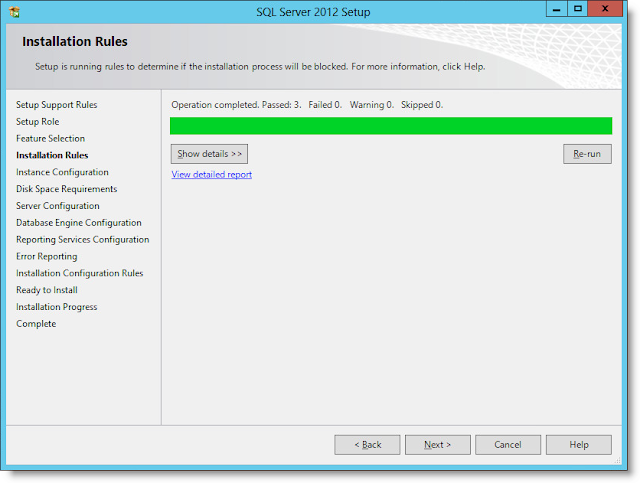I used a dedicated VM that will be used to host the database of Configuration Manager 2012 and Orchestrator 2012 (at least.. for now)
Resources
- Documentation - Microsoft SQL Server 2012 - Technet
- Download - Microsoft SQL Server 2012 - Technet
- Plan, Install, Upgrade, Uninstall, Failover Cluster - Technet
Installation
1 - After launching the SQL 2012 Server Installation, you should first run the System Configuration Checker. This small tool will check if you have every requirements to install SQL Server.
2 - The System Configuration Checker. As you can see, the Setup support Rules identify problems that might occur when you install SQL Server Setup support files. Failures must be corrected before Setup can continue.
3 - Select Installation on the left navigation pane and select New SQL Server stand-alone installation or add features to an existing installation

4 - Enter your Product key or select Specify a Free Edition if you just want to and evaluation version.
5 - Read and Accept the License terms.
Optionally you can check the "Send feature usage data to Microsoft...."
7 - On the Setup Support Rules, you can see that my firewall generate a warning.
I'll open the firewall later on. Click Next to continue
 |
| When you click on the Windows Firewall rule Warning Link, you'll see the information above |
8 - Select the standard Features to install, here I just need:
- Database Engine Services
- Reporting Services - Native
- Management Tools - Basic
- Management Tools - Complete
9 - Installation Rules - the Setup is running rules to determine if the installation process will be blocked.

10 - Specify the name and instance ID of the SQL Server Instance. By default: MSSQLSERVER. I continue with this setting and click Next.
12 - Specify the service accounts and collation configuration, here I set NT AUTHORITY\System for:
- SQL Server Agent
- SQL Server Database Engine
- SQL Server Reporting Services
 |
| Before |
 |
| After |
13 - Make sure the Database Engine is set to SQL_Latin1_general_CP1_CI_AS. If it's not the case, click on Customize, tick SQL Collation, used backwards compatibility, and select the good one in the list.
14 - In the next screen "Database Engine Configuration", specify the authentication mode and the administrators for the Database Engine. I added those:
- The Current User (in my case the Domain Administrator account)
- The Domain Admins Group
- The Local Administrator Account
15 - Specify the Reporting Services configuration mode.
Here I Selected Install and Configure
16 - Tick the "Send Windows and SQL Server Error Reports to Microsoft ..."
17 - The Setup is running rules to determine if the installation process will be blocked during the installation process.
18 - Verify the SQL Server 2012 features to be installed and click on Install.
Optionnaly you can check the ConfigurationFile.ini generated by the wizard. This can be reused for another installation. |
| ConfigurationFile.ini |
 |
| ConfigurationFile.ini can be found under c:\Program Files\Microsoft SQL Server\110\Setup Bootstrap\Log\ |
You can check the logs under c:\Program Files\Microsoft SQL Server\110\Setup Bootstrap\Log
20 - Finally you can launch SQL Server 2012 Management Studio to verify that everything run as expected.
























No comments:
Post a Comment